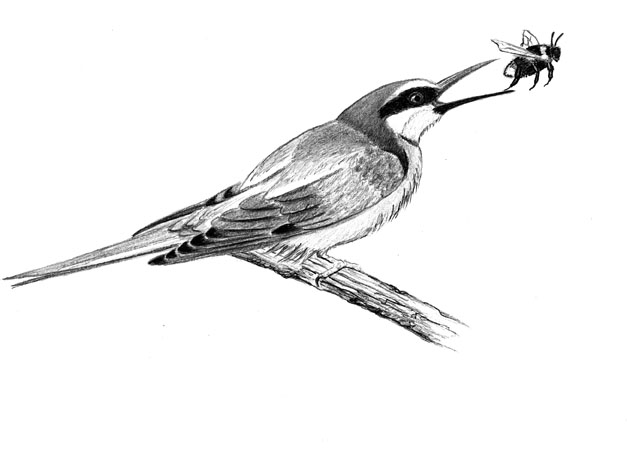
Dear Bird Folks,
While we were on a recent trip to London, I read a story in The Independent that was entitled, “An encounter with the most beautiful bird in Europe.” The story was about the “bee-eater,” a bird that was described as a “winged rainbow.” That got me wondering. What do you think is the most beautiful bird on Cape Cod?
– Ed, N. Truro and NYC
I never thought about it, Ed,
A few years ago someone wrote and asked me what my favorite bird was, which of course is the Blacked-capped Chickadee, the best bird ever. But no one has ever asked my choice for the Cape’s best-looking bird. I’m going to have to give this question some thought, and I hate doing that. Oh, it’s not the question. I like the question, but I hate doing anything that takes thinking (just like the U.S. Congress). But since you were nice enough to write to me, maybe I should make an exception and try to come up with an answer. Let’s see what happens.
Before we begin, I suggest everyone reading this should stop for a minute and try to find a color photo of a European Bee-eater. They are truly beautiful birds. I have no problem calling them “the most beautiful bird in Europe,” but it’s not like they have a lot of competition. Name another attractive bird in Europe. Can’t think of one, right? Remember, this is the place where the House Sparrow and the European Starling were invented. Oh sure, they do have a spiffy-looking kingfisher and a bird called the “Bluethroat” that’s pretty cool, but none of these birds can compare to a bee-eater. About the size of a mockingbird, bee-eaters have red-chestnut heads, golden backs, powder-blue bellies, bright-yellow throats and red eyes. Adult bee-eaters are covered in such an assortment of bright colors that they look like less like birds and more like ushers at the opening night of Cirque du Soleil.
As you might have guessed by the name, bee-eaters love bees, all kinds of bees. They eat small bees, big bees, honeybees and bumblebees (but not Bumblebee Tuna…they’ve heard the mercury rumors). Most other birds wisely avoid bees and their stingers, so bee-eaters have this pointy food source pretty much to themselves. Bee-eaters typically hunt by sitting on an exposed branch, waiting for an unsuspecting bee to fly past. When food is spotted, the birds will sally out, pluck the insect out of the air, fly back to the perch and then beat the snot out of it. At first they hammer the bee to kill it and then turn their attention to the still dangerous stinger. They swipe the backend of the bee back and forth, until the stinger falls off. Once the stinger is gone, it’s dinnertime.
Like our Belted Kingfishers, bee-eaters build their nests in underground burrows. They dig four-foot long tunnels into sandy cliffs or riverbanks. But unlike kingfishers, which hate one another’s guts, bee-eaters actually like each other and often breed in large colonies. As part of the courtship process, the male bee-eater will present his mate with a freshly beaten, stinger-free bee and feed it to her. (This may seem like an odd way to impress a female, but I can tell you from personal experience, it works quite well.) After mating, the female will lay her eggs in a nesting chamber at the end of the tunnel and both parents take turns incubating the eggs. When the eggs finally hatch out, the parents begin the demanding chore of feeding the babies, but don’t always do it alone. Occasionally they’ll get help from the neighbors. It seems that young male bee-eaters, birds that didn’t get “lucky” during the breeding season, will spend the summer helping other couples raise their families. Some experts theorize that pitching in improves the young bee-eaters’ parenting skills; others claim that these are birds that have gotten themselves into trouble and are now required to do this work as part of their community service.
The color and behavior of the bee-eater makes it one of the most admired birds in Europe. Who wouldn’t love a bird that looks like a rainbow and has the flying skills needed to capture bees? Well, I can think of one group that doesn’t love them…beekeepers. Bee-eaters eat lots of honeybees. For some reason, beekeepers aren’t cool with that, which has led to some ugly confrontations. Apparently, beekeepers aren’t as sweet as their honey.
When summer ends, bee-eaters have a long, dangerous migration to deal with. Cold weather causes bees to become less active, so the birds are forced to leave Europe and travel south to Africa. Migrating to Africa might not seem like a big deal. All the birds have to do is fly to Spain and then to Gibraltar, where they can practically see the African coast. But flying over water isn’t the problem; it’s flying across the vast Sahara Desert. Not only is the Sahara huge, but there’s no food for the birds to eat along the way. The only things the Sahara has to offer them are sand and camels, and the birds try to avoid those surly camels. Camels are always in a bad mood, unless, like the ad says, “it’s hump day.” Then they’re downright giddy.
Oops, sorry, Ed. I spent so much time yapping about bee-eaters I forgot to answer your question about the Cape’s most beautiful bird. I’ll have an answer for you next week, I promise. I just need a little more time to think about it. And maybe between now and then perhaps the U.S. Congress might also do some thinking. LOL.